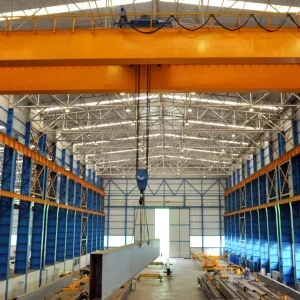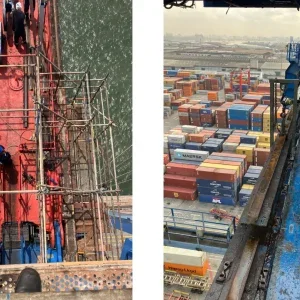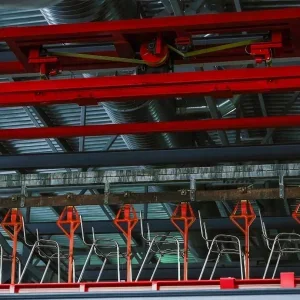The control of lifting equipment via radio remote control systems has become increasingly common throughout all industry sectors over the years and, far from being perceived as an ‘added extra’, it is now very much the norm.
It offers greater operational flexibility and, as the user can keep clear of the area where the hoist or overhead crane is working, it provides significant health and safety benefits. Another key factor in the growing demand for remote control is that the operators now working in the sector are likely to be of a generation that is much more at ease with console technology.
"The use of remote control technology is becoming much more mainstream," said Eugene Novak, product and development manager at Magnetek Radio Controls.
"OEMs and end users quite frequently request we include remote control technology with crane and hoist control systems," he continued, adding that, with Magentek’s acquisition by Columbus McKinnon Corporation (CMCO) earlier this year, the company is investigating the incorporation of Magnetek radio remote control into CMCO products. Radio remotes are currently available for use on virtually any CMCO electric hoist. In terms of whether the technology is included by OEMs as a matter of course, or only if the ultimate owner/end user has specified its inclusion, Ikusi identifies two main trends.
If the remote control system is conceived in its traditional sense of being a device just to control a crane’s manouvres, then the specification is likely to come from the ultimate user. If, however, radio control is seen from the crane manufacturer’s point of view then, according to Pedro Esnaola, Ikusi remote control director and Jose Ramón Elustondo, industry product manager, "synergies must exist between the crane’s electronic and remote control system".
"For this issue the crane must be sensorized and prepared for the integration of the remote control. As the crane includes more electronic features the remote control can interact with the crane operation. If we understand the radio remote control systems in this way, the more the equipment manufacturers will standardize and the more value they will provide."
In the majority of cases where standard lifting equipment is involved – although not exclusively – Konecranes includes radio remote control technology either optionally or in the main price. control with a spare transmitter and no back-up pendant," said Gordon Adie, director, industrial equipment, Europe west.
"In relation to process cranes, however, it is very much the end client that decides," he continued. "Even here, though, with cabin-controlled cranes, radio is being proposed as the back-up or alternative control station. There are exceptions to this, for example when it comes to hot metal and nuclear cranes. "Even an increased number of wasteto- energy (WTE) cranes are using radio control as the manual operation method when automation is perhaps switched off, which can be for variety of reasons. During maintenance, however, it is used in all cases."
Manufacturers of radio remote controls and lifting equipment alike cite safety and freedom of movement as two key drivers for adoption of the technology – and HBC radiomatic GmbH singles out speed as another benefit. "The use of radio controls allows for higher absolute speeds when moving the load because the operator does not need to walk beside the pendant," said Alexander Hemming, head of product management at HBC-radiomatic. "This is another aspect of the remote control which directly translates into a cost advantage.
"First and foremost, though, radio control technology provides freedom of movement that allows the operator to adopt the optimum working position independent of the machine.
"As a result, the operator can control the machine from a safe distance or move to favourable control positions offering improved fields of vision, ensuring that the operator is better able to monitor operation of the machine," said Hemming. "Remote controls can be essential for sustaining the well-being of personnel as there is less need for the operator to be directly exposed to heat, noise or vibration that might exist in the immediate proximity of the crane."
Magnetek agrees that by not "tethering" an operator to the equipment, they are able to move freely around the load and ensure they are in the safest position, while still being able to monitor the operation visually.
"From an efficiency standpoint, moving from a cab-operated crane to floor operation eliminates the need for a spotter/rigger on the floor, thereby reducing labour costs," said Novak.
"In high-speed cranes with long runways, we can utilize a two-operator movement called pitch and catch," he continued. "Pitch and catch allows the operators at each end of the crane runway to hand off operation of the crane to/from one another."
While undeniably burdensome, safety legislation is generally seen as a good thing by manufacturers.
"While these safety standards will sometimes dictate design and implementation decisions for a product, they ultimately ensure it is safe," said Novak. "There are a number of different standards used worldwide but many of these are harmonizing with the European Union’s EN standards. Many countries and locations will accept products that have been designed to meet EN standards."
At HBC-radiomatic the harmonization of safety standards is seen as a necessary and helpful development in the lifting equipment sector and it has welcomed the recognition and, in some cases adoption, of EU standards in countries outside the region.
"Where international safety standards and market access procedures have not been fully harmonized, a level of complexity is added in distributing radio control systems in non-European markets," said Hemming.
"While the safety targets are often identical, the procedures to establish conformity with applicable standards might differ and may involve straightforward registration, inspection of technical documentation or a prototype test against the background of the applicable technical standards in the destination country. Therefore, distributing radio control systems in non-European countries is likely to cause some additional effort compared to Europe."
While any overhead crane can be operated using radio remote control technology, operations in which there are potentially hazardous conditions or hazardous materials being lifted have the greatest need for the operator to work at a distance, said Magnetek/ CMCO, highlighting nuclear, dip tank, paint line and hot metal applications as particular examples.
Applications also include tandem crane lifts or transfer cranes and multimonorails. "Tandem crane operations use two or more cranes to lift larger equipment," said Novak. "Radio controls used in tandem crane applications need to accurately communicate the status of each crane to the operator and the other crane to ensure safe operation. "Transfer cranes and multi-monorails often have multiple user stations to which operators are handing off control of the equipment. In these scenarios, radio control is the only way to control the movements efficiently."
Ikusi agrees that "complex and dangerous" processes within the heavy control with a spare transmitter and no back-up pendant," said Gordon Adie, director, industrial equipment, Europe west.
"In relation to process cranes, however, it is very much the end client that decides," he continued. "Even here, though, with cabin-controlled cranes, radio is being proposed as the back-up or alternative control station. There are exceptions to this, for example when it comes to hot metal and nuclear cranes. "Even an increased number of wasteto- energy (WTE) cranes are using radio control as the manual operation method when automation is perhaps switched off, which can be for variety of reasons. During maintenance, however, it is used in all cases."
Manufacturers of radio remote controls and lifting equipment alike cite safety and freedom of movement as two key drivers for adoption of the technology – and HBC radiomatic GmbH singles out speed as another benefit. "The use of radio controls allows for higher absolute speeds when moving the load because the operator does not need to walk beside the pendant," said Alexander Hemming, head of product management at HBC-radiomatic. "This is another aspect of the remote control which directly translates into a cost advantage.
"First and foremost, though, radio control technology provides freedom of movement that allows the operator to adopt the optimum working position independent of the machine.
"As a result, the operator can control the machine from a safe distance or move to favourable control positions offering improved fields of vision, ensuring that the operator is better able to monitor operation of the machine," said Hemming. "Remote controls can be essential for sustaining the well-being of personnel as there is less need for the operator to be directly exposed to heat, noise or vibration that might exist in the immediate proximity of the crane."
Magnetek agrees that by not "tethering" an operator to the equipment, they are able to move freely around the load and ensure they are in the safest position, while still being able to monitor the operation visually.
"From an efficiency standpoint, moving from a cab-operated crane to floor operation eliminates the need for a spotter/rigger on the floor, thereby reducing labour costs," said Novak.
"In high-speed cranes with long runways, we can utilize a two-operator movement called pitch and catch," he continued. "Pitch and catch allows the operators at each end of the crane runway to hand off operation of the crane to/from one another."
While undeniably burdensome, safety legislation is generally seen as a good thing by manufacturers.
"While these safety standards will sometimes dictate design and implementation decisions for a product, they ultimately ensure it is safe," said Novak. "There are a number of different standards used worldwide but many of these are harmonizing with the European Union’s EN standards. Many countries and locations will accept products that have been designed to meet EN standards."
At HBC-radiomatic the harmonization of safety standards is seen as a necessary and helpful development in the lifting equipment sector and it has welcomed the recognition and, in some cases adoption, of EU standards in countries outside the region.
"Where international safety standards and market access procedures have not been fully harmonized, a level of complexity is added in distributing radio control systems in non-European markets," said Hemming.
"While the safety targets are often identical, the procedures to establish conformity with applicable standards might differ and may involve straightforward registration, inspection of technical documentation or a prototype test against the background of the applicable technical standards in the destination country. Therefore, distributing radio control systems in non-European countries is likely to cause some additional effort compared to Europe."
While any overhead crane can be operated using radio remote control technology, operations in which there are potentially hazardous conditions or hazardous materials being lifted have the greatest need for the operator to work at a distance, said Magnetek/ CMCO, highlighting nuclear, dip tank, paint line and hot metal applications as particular examples.
Applications also include tandem crane lifts or transfer cranes and multimonorails. "Tandem crane operations use two or more cranes to lift larger equipment," said Novak. "Radio controls used in tandem crane applications need to accurately communicate the status of each crane to the operator and the other crane to ensure safe operation. "Transfer cranes and multi-monorails often have multiple user stations to which operators are handing off control of the equipment. In these scenarios, radio control is the only way to control the movements efficiently."
Ikusi agrees that "complex and dangerous" processes within the heavy at any time and in any situation is paramount. As of today, large-scale networks for off-site control do not yet provide real-time access to the safety functions of the crane."
"Operators should always have sight of the lifted load, either remotely or by direct sight and this is an area where great care is needed," added Adie.
"In the case of extremely remote radio controlled operation, then security in the working area of the cranes is of paramount importance and dictates that there should be no personnel allowed to enter the parameters of the working space.
"Tandem control of cranes has been around for years, even controlling perhaps three cranes from one radio system, but the rules today dictate that the cranes must be monitoring each other and if one crane stops, or a motion stops, then they all have to stop." Factors end users should consider when specifying radio remote control systems are, of course, reliability, an efficient after sales service and what Ikusi refers to as the possibility of setting up "through the plug and play philosophy".
It is also crucial that the correct system to suit the configuration of equipment on the crane is specified and that operators are fully trained. Once the correct system has been selected, frequency management is a challenge operators must get to grips with. This entails maintaining accurate records regarding which devices in a facility are using which frequencies and where.
"With that documentation, informed decisions can be made regarding which frequencies new equipment should use in order to minimize any conflicts in the airways, ensuring a reliable wireless link," said Novak.
"Frequency management not only plays a part in the proper planning for pending crane radio controls, it reaches beyond as more and more devices today are operating wirelessly and can compete with each other."
And, he added, it’s important to keep abreast of new developments in the field. "Innovations in wireless technology are developing at a rapid pace, so it can be a challenge for end users and crane builders/service providers to stay current on all the functionality radio controls offer."
One such development is haptic feedback – the use of the operator’s sense of touch in the form of a vibration. Magnetek says it hasn’t seen much call for the technology thus far but it sees the benefits of the technology, which can alert the operator to alarm or error conditions, and is designing it into new products.
Meanwhile, Ikusi’s experience is of an increasing trend towards haptic feedback.
"The operator has more interaction with the machinery and, owing to the detection of dangerous or unwanted situations, this makes the operation safer," said Esnaola.
"However, in order to use this kind of feedback in the remote control devices the machine must be sufficiently sensorized.
This underlines the need to take advantage of the synergies between remote control system and crane manufacturers "






